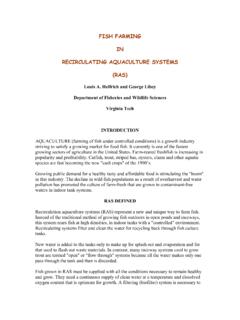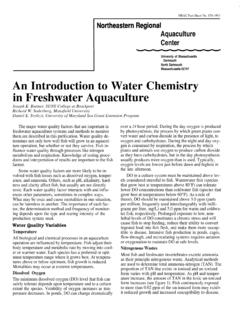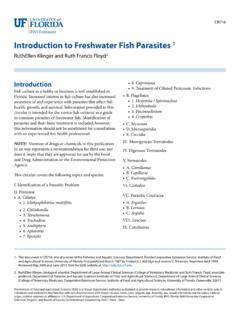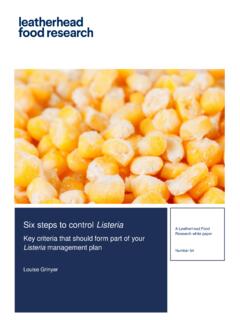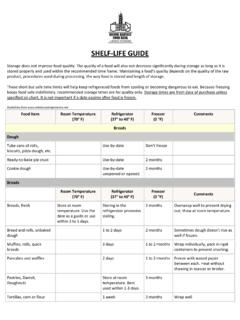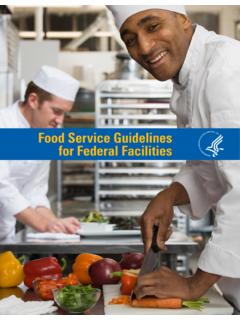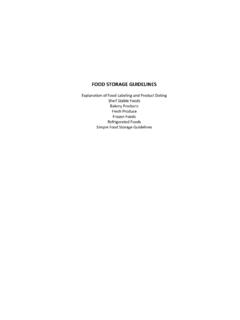Transcription of Publication 420-25 Understanding Fish Nutrition, Feeds ...
1 Publication by Communications and Marketing, College of Agriculture and life Sciences, Virginia Tech, 2017 Virginia Cooperative Extension programs and employment are open to all, regardless of age, color, disability, gender, gender identity, gender expression, national origin, political affiliation, race, religion, sexual orientation, genetic informa-tion, veteran status, or any other basis protected by law. An equal opportunity/affirmative action employer. Issued in furtherance of Cooperative Extension work, Virginia Polytechnic Institute and State University, Virginia State University, and the Department of Agriculture cooperating. Edwin J. Jones, Director, Virginia Cooperative Extension, Virginia Tech, Blacksburg; M. Ray McKinnie, Administrator, 1890 Extension Program, Virginia State University, Petersburg. VT/0517/420-256/FST-269 PGood nutrition in animal production systems is essential to economical production of a healthy, high-quality product.
2 In fish farming (aquaculture), nutrition is critical because feed typically represents approximately 50 percent of the variable production cost. fish nutrition has advanced dramatically in recent years with the development of new, balanced commercial diets that promote optimal fish growth and health. The development of new species-specific diet formulations supports the aquaculture industry as it expands to satisfy increasing demand for affordable, safe, high-quality fish and seafood Produced FeedsPrepared or artificial Feeds can be either complete or supplemental. Complete diets supply all the ingredients (protein, carbohydrates, fats, vitamins, and minerals) necessary for the optimal growth and health of the fish . Most fish farmers use complete diets, typically made up of the following components and percentage ranges: protein, 18-50 percent; lipids, 10-25 percent; carbohydrate, 15-20 percent; ash, < percent; phosphorus, < percent; water, <10 percent; and trace amounts of vitamins and minerals.
3 The nutritional content of the feed depends on what species of fish is being cultured and at what life stage. When fish are reared in high-density indoor systems or confined in cages and cannot forage freely on natural food ( , algae, aquatic plants, aquatic invertebrates, etc.), they must be provided a complete diet. In contrast, supplemental ( , incomplete or partial) diets are intended only to help support the natural food normally available to fish in ponds or outdoor Understanding fish nutrition , Feeds , and FeedingSteven Craig, Assistant Professor, Virginia-Maryland College of Veterinary Medicine, Virginia TechLouis Helfrich, Fisheries and Wildlife Sciences, Virginia TechRevised by:David D. Kuhn, Assistant Professor and Extension Specialist, Department of Food Science and Technology, Virginia TechMichael H. Schwarz, Director, of Virginia Seafood Agricultural Research and Extension Center, Virginia Techraceways.
4 Supplemental diets do not contain a full complement of vitamins or minerals but are typically used to help fortify the naturally available diet with extra protein, carbohydrate, and/or Because protein is the most expensive component of fish feed , it is important to accurately determine the protein requirements for each species and life stage cultured. Proteins are formed by linkages of individual amino acids. Although more than 200 amino acids occur in nature, only about 20 amino acids are common. Of these, 10 are essential (indispensable) amino acids that cannot be synthesized by fish . The 10 essential amino acids that must be supplied by the diet are methionine, arginine, threonine, tryptophan, histidine, isoleucine, lysine, leucine, valine, and phenylalanine. Of these, lysine and methionine are often the first limiting amino acids.
5 fish Feeds prepared with plant protein ( , soybean meal) are typically low in methionine. Meanwhile, fish Feeds manufactured with bacterial or yeast proteins are often deficient in both methionine and lysine. Therefore, these amino acids must be supplemented to diets when these sources of proteins are used to replace fishmeal. It is important to know and provide the dietary protein and specific amino acid requirements of each fish species to promote optimal growth and health. Protein levels in aquaculture Feeds generally average 30 to 35 percent for shrimp, 28-32 percent for catfish, 35-40 percent for tilapia, 38-42 percent for hybrid bass, and 40-45 percent for trout and other marine finfish. In general, protein requirements are typically lower for herbivorous fish (plant-eating) and omnivorous fish (plant and animal eaters) than they are for carnivorous (flesh-eating) fish .
6 Protein requirements are higher for fish reared in high-density systems ( , recirculating aquaculture) compared to low-density culture ( , ponds).Protein requirements are generally higher for smaller as well as early life stage fish . As fish grow larger, their protein requirements usually decrease. Protein requirements also vary with rearing environment, water temperature, and water quality, as well as the genetic composition and feeding rates of the fish . Protein is used for fish growth if adequate levels of fats and carbohydrates (energy) are present in the diet. If not, the more expensive protein can be used for energy and life support rather than are composed of carbon (50 percent), nitrogen (16 percent), oxygen ( percent), and hydrogen ( percent), and other elements ( percent). fish are capable of using a high-protein diet, but as much as 65 percent of the protein can be lost to the environment.
7 Most nitrogen is excreted as ammonia (NH3) from the gills of fish , and only 10 percent is excreted as solid wastes. Eutrophication (nutrient enrichment) of surface waters due to excess nitrogen from fish farm effluents can be a significant water quality concern for fish farmers. Appropriate Feeds , feeding strategies, and waste management practices are essential to protect downstream water (fats) are high-energy nutrients that can be utilized to partially spare (substitute for) protein in aquaculture Feeds . Lipids have about twice the energy density of proteins and carbohydrates. Lipids typically make up about 7-15 percent of fish diets, supply essential fatty acids, and serve as transporters for fat-soluble recent trend in fish Feeds is to use higher levels of lipids in the diet. While increasing dietary lipids can help reduce the high costs of feed by partially sparing protein in the feed , problems such as excessive fat deposition in the liver can decrease fish health, quality, and shelf life of the final product.
8 Simple lipids include fatty acids and triacylglycerols. fish typically require fatty acids of the omega-3 and -6 (n-3 and n-6) families. Fatty acids can be (a) saturated fatty acids (no double bonds), (b) polyunsaturated fatty acids (>2 double bonds), or (c) highly unsaturated fatty acids (>4 double bonds). Marine fish and algal oils are naturally high in omega-3 highly unsaturated fatty acids (>30 percent) and are excellent sources of lipids for the manufacture of fish diets. Lipids from these sources can be deposited into fish muscle. People who then consume these fillets could enjoy the health benefits of consuming foods rich in omega-3 fatty acids, such as reduced symptoms of depression and improved cardiovascular health. Marine fish typically require omega-3 fatty acids for optimal growth and health, usually in quantities ranging from percent of the dry diet.
9 The two major essential fatty acids of this group are eicosapentaenoic acid (EPA: 20:5n-3) and docosahexaenoic acid (DHA: 22:6n-3). Freshwater fish do not require the long-chain highly unsaturated fatty acids but often require an 18-carbon n-3 fatty acid, linolenic acid (18:3-n-3), in quantities ranging from to percent of dry diet. This fatty acid cannot be produced by freshwater fish and must be supplied in the diet. Many freshwater fish can elongate and desaturate linolenic acid using enzyme systems resulting in longer-chain omega-3 fatty acids EPA and DHA, which are necessary for other metabolic functions and as cellular membrane components. Marine fish typically do not possess these elongation and desaturation enzyme systems and require long-chain omega-3 fatty acids in their diets. Other fish species, such as tilapia, require fatty acids of the n-6 family, while others, such as catfish, require a combination of n-3 and n-6 fatty acidsCarbohydratesCarbohydrates (starches and sugars) are the least expensive sources of energy for fish diets.
10 Although not essential, carbohydrates are included in aquaculture diets to reduce feed costs and for their binding activity during feed manufacturing. Dietary starches are useful in the extrusion manufacture of floating Feeds . Cooking starch during the extrusion process makes it more biologically available to fish , carbohydrates are stored as glycogen that can be mobilized to satisfy energy demands. They a major energy source for mammals but are not used efficiently by fish . For example, mammals can extract about 4 calories of energy from 1 gram of carbohydrate, whereas fish can only extract about calories from the same amount of carbohydrate. fish can use up to about 20 percent of dietary are organic compounds necessary in the diet to support normal fish growth and health. They are often not synthesized by fish and must be provided in the diet.
